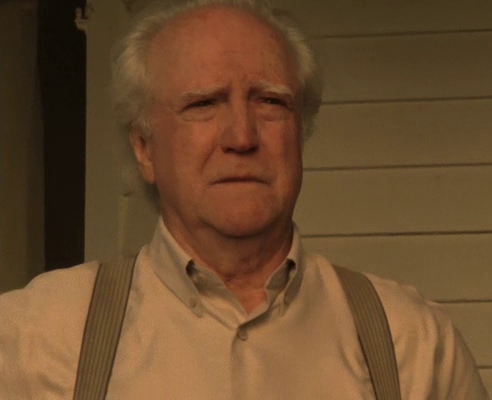The dead family that Michonne finds reminds her and the audience of her life before the zombie infections. The girls laying on the bed recall family values and the pink resembles carelessness. These are values that are no longer present in the post-apocalyptic world. Lighting can reveal much about a situation or character and perhaps even foreshadow an event. In this scene, low key lighting reveals much about the Governor.
The shadow caused by the low key lighting reveals the lack of humanity the Governor has. The shadow is on the same side of his face as his eye-patch. When he was stabbed in the eye he snapped and lost his sense of community and humanity. The brightness on the right side of his face brings attention to his wide open eye. This shows his pent up hatred and insanity. Space greatly affects how the audience reads the film. Utilization of space can shove reality right in the audiences face or leave them completely confused depending on the directors intent. Essentially, this ties together moods and relationships between elements in the world the characters must live in. In the beginning of the series a famous shot of Rick riding into Atlanta on his horse reveals the entirety of the situation he missed out on because he was healing in the hospital.


For example, Hershel started out as a man on a ranch who held traditional values close and protected "walkers" who he still considered friends and family members. His clothes were completely clean and his beard was shaven. As he realizes that the world is changed and goes through many survival experiences, his clothes become worn out and his beard and hair are unkempt. This shows how the environment changed a very faithful man into a survivor. Much of the show is based off drama through acting. Emotional ties make up the base of the show and eventually lead to the biggest events in the show. Acting also reveals elements about each character and intensifies the audiences feelings about those characters.

Lizzie is a character who is perceived by the audience as a psycho because of the way she acts. She is seen in multiple scenes playing with walkers like they are her friends. She also feeds zombies rats at the jail which attracted more of them. Eventually, she kills her sister because she believes she will come back and will be "ok". Lizzie's acting reveals her as a character and shows how she is an outcast because despite how long she has been in the apocalypse, she still doesn't understand that zombies want to eat her.
Cinematography is the composure of a shot and the elements in it. These change how the film is received by the audience and can create suspense, confusion, awe, and other moods. Aspects of cinematography include quality, framing, scale, and movement. Quality is the balance of light and dark, the focus, relation of foreground and background etc. This helps create an appropriate setting for the film, quality is essential because it creates the feel of a shot.

In the scene where Rick kills Tomas, there are perfect examples of quality that create an image that causes surprise in the audience. The colors in the shot are all bland colors to create less vivid scene.The focus is on the man in the back more than Thomas and Rick to show his surprise at Rick's actions. The lighting is on the characters and is darker on the right side of the screen to show evil vs. good. Framing is the way the camera is positioned to a character or scene and how the camera acts in relation to that object. This can create suspense, chaos, dizziness, confusion, connections to the character's feelings, unawareness, and any other elements the director intends.

This shot's framing helps to focus on two important things. It is zoomed only on the door and on Meryl's face to show Meryl's fear of the situation he is in. He is in pain because he is stuck and trying to escape a zombie horde. Scaling can show the environment a character is in and even instill feelings in the characters. A great example of this is when Michonne enters the Governor's layer.


Multiple shots show Michonne in a room with the Governor's walker daughter. Most of the shots are medium close-ups. There are also many severed heads in tanks and the room itself is very small. This puts Michonne in a claustrophobic environment especially with the Governor right outside the door. The audience feels what Michonne is feeling due to the scaling of the shots in this scene. Movement is another great aspect of filming that often is used in action shots, dynamic shots, or even to suggest a stalker in the premises.
In this scene, the camera movement pans from the sword the Governor is pulling away from Hershel's neck to Rick standing on the other side of the fence. This is a hand held camera scene because it seems to be from the Governor's view. This brings hope to the audience as they see both the sword being pulled away and Rick's reaction. This hope is then squandered when the Governor executes Hershel. This shows how a simple shot with camera movement can make a scene much more dramatic and unpredictable.




No comments:
Post a Comment